Beekeeping is an intricate art and science that carefully manages honey bee colonies yearly. This blog will explore the season-wise management practices crucial for these remarkable insects’ well-being. From spring to winter, each season brings unique challenges and opportunities for beekeepers. By understanding the specific needs of honey bees during different times of the year, we can ensure their health, productivity, and the production of high-quality honey.
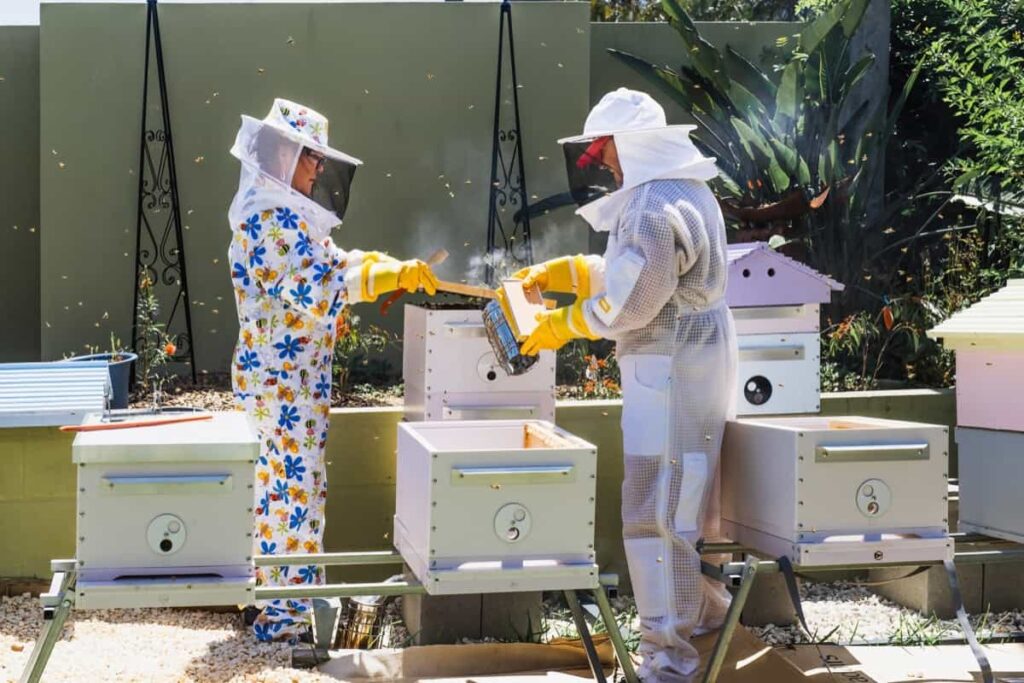
Introduction to Beekeeping Management Practices
Beekeeping management practices encompass a series of precise steps and strategies to ensure the health and productivity of honey bee colonies. Throughout the year, these practices vary in response to seasonal changes. In spring, beekeepers focus on colony expansion and swarm prevention. As summer arrives, they monitor for diseases and pests while providing sufficient nectar and pollen sources. Fall requires preparation for winter, including feeding bees and insulating hives. During winter, hives need protection from the cold. These practices are based on scientific data and knowledge of bee biology.
Spring Management of Honey Bee Colonies
Spring marks a crucial season for beekeepers, signaling the beginning of favorable conditions for honey bee colonies. Specific management practices ensure their health and productivity during this vital period.
Removing Hive Coverings: In early spring, lightly packed hives should have their protective coverings removed. Heavily packed colonies should only have their packing removed when the daily maximum temperature reaches 16°C.
Colony Examination: On sunny days, colonies should be examined. This examination should be brief to prevent brood chilling and robbing. Assess the food stores and overall colony condition.
Equalizing Colony Strength: Normal colonies in an apiary can be strengthened by providing brood frames to needy colonies.
Addressing Queenless Colonies: Colonies without brood may lack a queen or have a drone-laying queen. Weak colonies (less than five frames) should be united with other needy normal colonies. Strong queenless colonies can be provided with a mated queen or a frame of brood with eggs and young larvae for queen rearing.
Stimulatory Feeding: As spring begins with the blooming of flowers, provide stimulatory feeding of sugar syrup (30% dilution) to bee colonies. Prevent robbing by taking appropriate precautions. Bees focus on brood rearing during this period.
Space for Brood Rearing: Offer raised combs or frames with comb foundation sheets if raised combs are unavailable. Avoid excessive brood expansion during uncertain early spring weather to prevent brood chilling. This risk diminishes once the colony is strong enough to cover the brood.
Regular Colony Inspection: Inspect colonies at least once a week on sunny days. When conditions allow, clean debris from the bottom boards provides empty frames based on colony needs. Ensure that each colony maintains a minimum of 5 kg of food stores.
In case you missed it: Beekeeping in South Africa: Requirements, License, Cost, and Training to Start
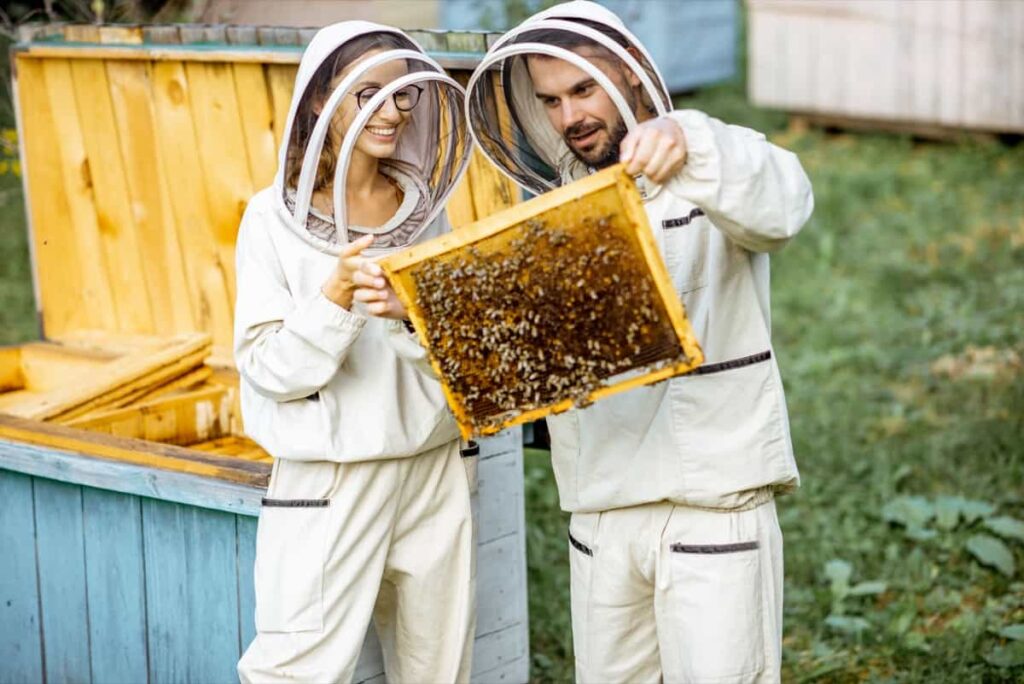
Combating Spring Dwindling: Old bees naturally die off in spring and are replaced by young bees. If the mortality of old bees surpasses the emergence of young bees, it leads to spring dwindling. Address this by providing adequate pollen and honey stores and offering 1-2 sealed brood frames from strong colonies.
Summer Management of Honey Bee Colonies
Summer brings challenges for beekeepers, and effective management practices are crucial to ensure the well-being of honey bee colonies during this season.
- Wet Gunny Bags: To control the microclimate within the colony, place wet gunny bags over the top cover. This helps in temperature regulation.
- Sprinkling Water: During noon hours, sprinkle water on and around the colonies in the apiary to relieve the heat.
- Proximity to Clean Water: Ensure clean and fresh water sources are easily accessible near the colonies.
- Water Inside Hives: Fresh water can also be fed inside the hives. Initially, bees may not use it for the first 2-3 days, but they will eventually benefit from it.
- Shade Placement: Keep colonies under thick shade, ideally along avenues of trees or bushes. This prevents colonies from being exposed to high temperatures and hot, westerly winds during the summer.
- Wide Entrances: Ensure the colony’s entrance is wide enough to maintain proper ventilation, allowing air circulation.
- Multi-Chambered Colonies: Consider providing additional gates to facilitate ventilation for multi-chambered colonies.
- Frame Reduction: During summers, reduce the number of frames in the hive by one. This eases the bees’ workload.
- Adding Supers: Place an extra super with empty frames (without combs or comb foundation) in the hive. This provides the bees with room to expand their cluster and store honey.
- Ensuring Air Flow: Place a thin stick or spacer between two adjacent chambers to sustain fresh airflow between chambers. This helps maintain optimal ventilation within the hive.
Monsoon Management of Honey Bee Colonies
- Shade and Air Flow: Move the apiary and colonies under shade with proper airflow to prevent humidity from stagnating, which can harm bee colonies.
- Clean Apiaries: Keep the apiary and colonies clean. Change the bottom boards frequently with clean and dry ones to maintain hive hygiene.
- Sugar Syrup and Pollen Substitute: Provide thick sugar syrup and pollen substitute as needed to meet the nutritional requirements of the colonies during monsoon.
- Separate Weak Colonies: Keep weak, diseased, and laying worker colonies together in a separate yard to prevent issues from spreading.
- Non-Toxic Methods: Employ non-toxic methods to control predator attacks on the colonies. Protecting colonies from predators is essential during this season.
In case you missed it: Backyard Beekeeping Cost and Tips for Reducing Backyard Beekeeping Costs
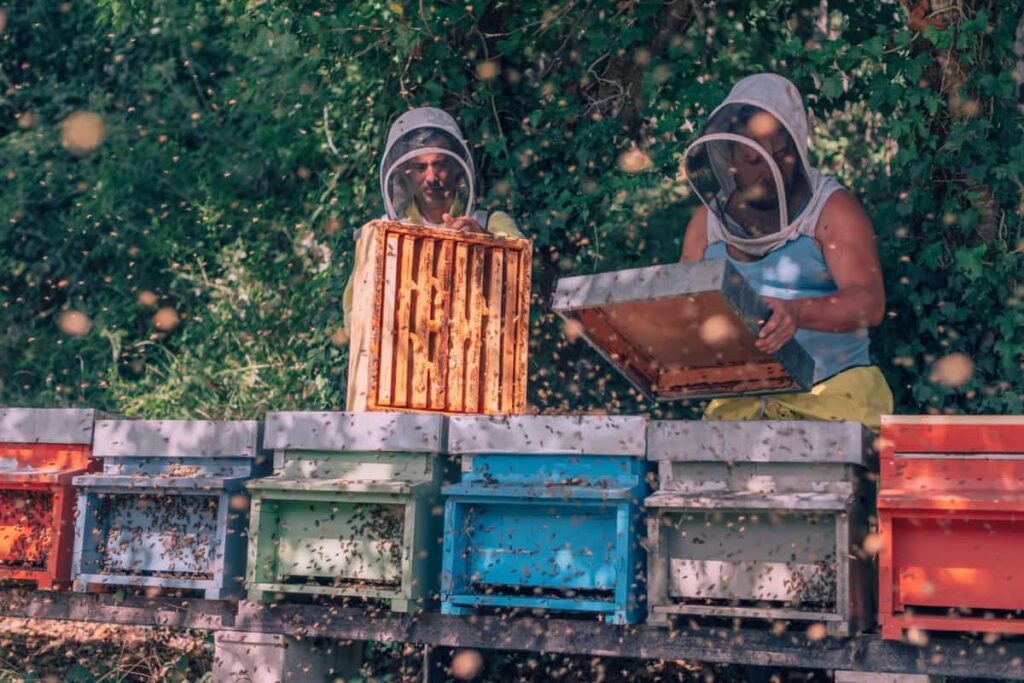
Autumn Management of Honey Bee Colonies
- Adequate Ventilation: Ensure enough space within the colonies for ventilation and bee movement to prevent overcrowding.
- Nighttime Sugar Feeding: Stimulate brood rearing by providing simulative sugar feeding at night. This helps boost colony strength.
- Old Comb Removal: Clear out old black combs and those infested with pests. These can be collected and boiled with water to separate the wax. Replace them with clean new combs.
- Control Ectoparasites: Vigilantly controls ectoparasitic mites, wax moth infestations, and predatory wasps, which can harm bee colonies.
- Stimulate Comb Building: When fresh wax or comb-building activity is observed, provide colonies with frames containing fresh comb foundation.
- Sugar Syrup Feeding: Feed the colonies with a (50:50) sugar syrup for 3-4 days. Even darker combs can be replaced with new comb foundation frames. This stimulates new comb construction and increases brood rearing.
Winter Management of Honey Bee Colonies
Plains and Foot Hills of India
Winter is a productive period for beekeeping in the plains and foothills of India, but it requires specific management practices to ensure colony health and productivity
- Late Autumn and Early Winter: Continue adding new comb foundation to stimulate brood rearing in the colonies.
- Queen Rearing and Swarm Control: As drone brood appears, take action for queen rearing and swarm control.
- Select Quality Queen Cells: In colonies chosen for queen rearing, select and mark larger-sized queen cells to rear high-quality queens.
- Add Supers: Preferably, half or shallow supers with drawn combs or new comb foundation should be added to full 9 to 10 frame bee colonies.
- Prepare Additional Supers: Have more supers ready for use, either for additional colonies or as supers get filled and sealed.
- Prepare for Extraction: Make arrangements for hygienic and contamination-free honey extraction and handling as supers fill and seal.
Higher Hills with Severe Winters
- Regular Colony Inspection: Examine colonies regularly to ensure their well-being during the harsh winter conditions.
- Provide Sunlight: Shift colonies to locations with sufficient sunlight to keep them warm.
- Winter Covers: Weak colonies should be provided with winter covers to protect them from the cold.
- Stimulative Feeding: Feed sugar syrup or pollen substitute to weak colonies. This provides energy and initiates brood rearing, helping them survive the winter.
- Wind Breakers: Use windbreakers to shield bees from chilly and frosty winds, preventing excessive heat loss.
- Unite Weak Colonies: Weaker colonies should be united with stronger ones to improve their chances of survival.
In case you missed it: 11 Best Beekeeping Suits for Men and Women: Prices Included for Beekeepers in the USA
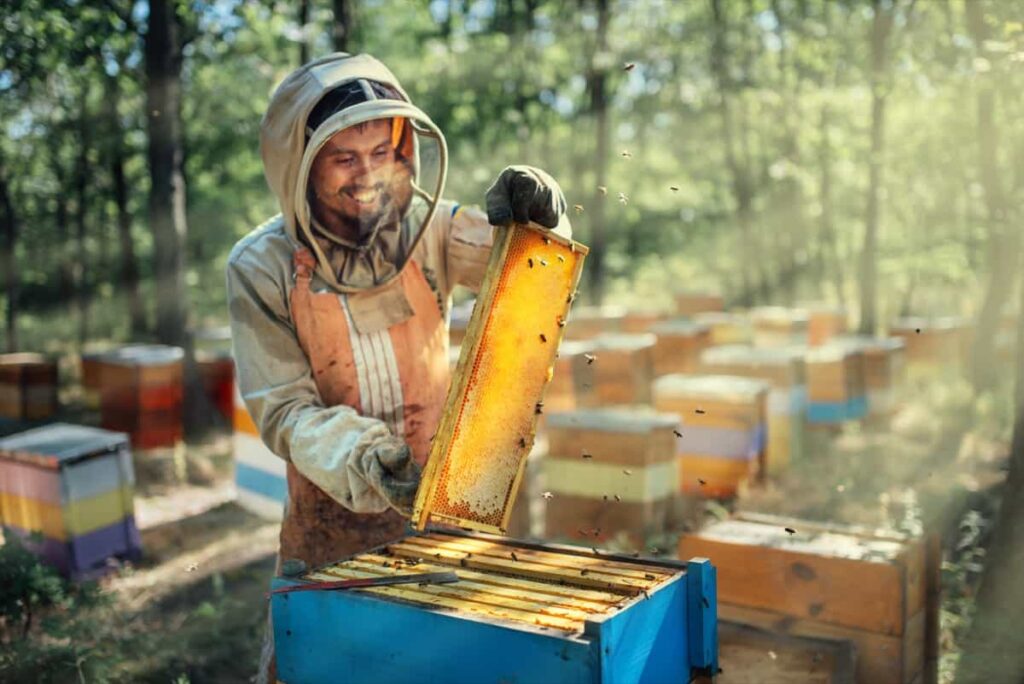
Swarm Prevention and Control in Beekeeping
Swarming is an instinct in honey bee colonies, where worker bees leave the hive with the old queen, temporarily settling on nearby branches. It occurs when the queen has reached her peak of brood rearing, often stimulated by pollen and nectar. Swarming usually take in late spring or early summer but can occur in summer or fall, depending on local conditions. Causes of swarming include overcrowding, inadequate ventilation, the presence of an old queen, sudden nectar flow, and insufficient space for egg-laying and honey storage.
Swarming can lead to a loss of workforce, reduced honey collection, and genetic variability in swarming behavior. Indicators of swarming include numerous queen cells along the lower edges of combs and bees clustering outside the hive due to overcrowding. Swarms usually occur between 10 AM and 2 PM on sunny days but may depart earlier or later in the evening in unfavorable weather conditions.
Queen Rearing and Replacement Techniques in Beekeeping
To maintain strong honey bee colonies, queen rearing, and replacement are crucial in beekeeping. This process involves selecting a healthy colony, transferring larvae into special queen cups, nurturing queens in queenless or queenright colonies, and introducing newly emerged queens to the target colony. This ensures a smooth transition and maintains the health of the bees.
Disease and Pest Management in Honey Bee Colonies
Honey bee colonies face several common diseases and pests. Varroa mites, caused by microsporidian parasites, transmit viruses and weaken bees. Management involves chemical treatments, integrated pest management, and breeding for mite-resistant bees. Nosema disease, caused by microsporidian parasites, affects the bee’s gut. Control includes fumagillin treatment and maintaining strong colonies.
American and European Foulbrood, Small Hive Beetle, wax moths, chalkbrood, and sacbrood viruses can devastate colonies. Control involves burning infected hives and antibiotic treatment. Prevention involves traps, oil trays, and maintaining strong colonies. Control measures include chalkbrood, improved hive ventilation, and requeening.
Nutrition and Feeding Practices for Honey Bees
Honey bee nutrition is crucial for their health and production. They need a balanced diet of nectar, pollen, and water. Feeding practices include supplementing with sugar syrup or honeybee feed during nectar scarcity, providing pollen substitutes when natural pollen is scarce, ensuring clean water for proper digestion and temperature regulation, and adjusting feeding based on seasonal demands to support colony growth and honey production.
In case you missed it: Honeybee Farming Operations Management: Month-Wise Beekeeping Maintenance for Better Profits
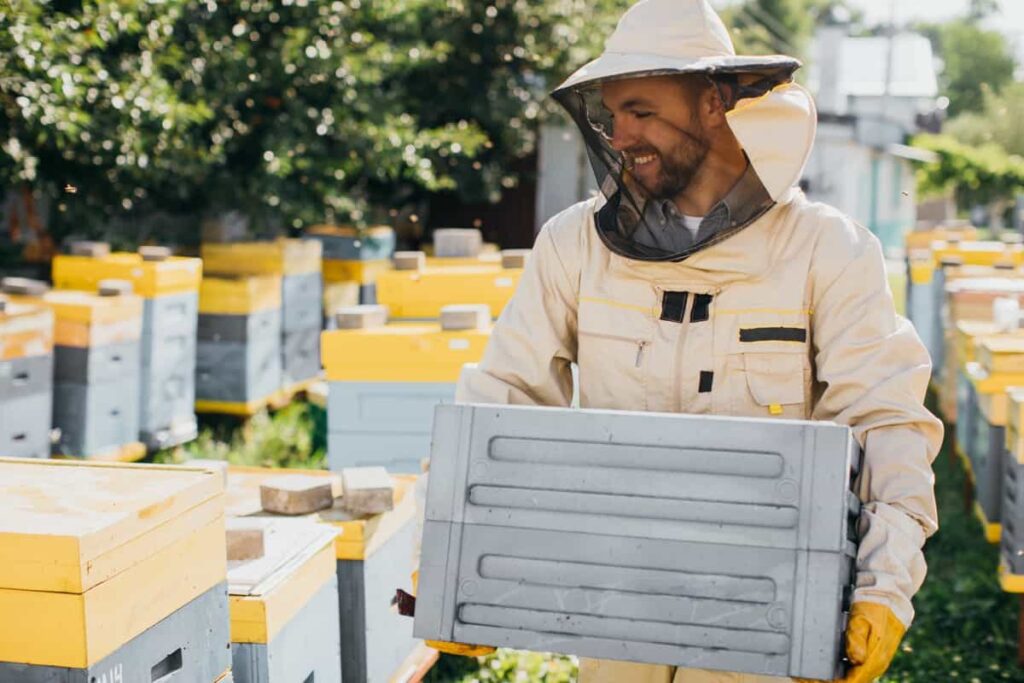
Hive Inspection and Record-Keeping in Beekeeping
Regular hive inspections are essential for monitoring colony health every 1-2 weeks during active seasons. These inspections should be conducted on warm, sunny days when bees are foraging, using protective gear. The objective is to check for diseases, pest infestations, queen health, brood patterns, honey stores, and overall hive condition. Record-keeping involves data collection, logging, tracking trends, and documentation of treatments, medication, or feedings administered to the hive. This helps in making informed management decisions and identifying patterns in hive performance.
Honey Harvesting and Processing Techniques
- Timing: Harvest honey when it reaches 18-20% optimal moisture content. This ensures better shelf life and prevents fermentation.
- Smoking: Before harvesting, use a smoker to calm the bees. Gently brush them off frames to avoid damage.
- Uncapping: Employ a heated knife or uncapping fork to remove wax capping from honeycomb cells. Collect the cappings for processing.
- Extraction: Place uncapped frames in a honey extractor, which spins the frames to extract honey. Gravity can also be used.
- Filtering: Filter the extracted honey to remove debris, wax particles, and air bubbles. Use a fine mesh or cloth for this purpose.
- Settling: Allow the filtered honey to settle in a settling tank for a day or two. This helps separate any remaining impurities or air bubbles.
- Bottling: Transfer the clarified honey into clean, dry, sterilized jars or containers. Avoid overheating, as it can damage the honey’s quality.
- Storage: Store honey in a cool, dry place to prevent crystallization. Maintain proper labeling for traceability.
- Processing Wax: Process the collected wax cappings for beeswax products, such as candles or cosmetics.
Pollination Services and Beekeeping Management
Beekeeping for agriculture, providing essential pollination services. Effective beekeeping management involves strategic hive placement, maintaining healthy colonies with proper nutrition and disease control, engaging in pollination contracts with farmers, regular hive inspections, and reducing pesticide exposure. Sustainable practices, such as reducing pesticide exposure, contribute to long-term pollination success and enhance crop yields and quality.
Hive Construction and Equipment Maintenance in Beekeeping
Hive construction involves assembling beehives with precision. Key aspects include choosing durable materials, ensuring proper ventilation, and crafting hive components like boxes and frames. Equipment maintenance is equally critical for hive longevity and bee health. Routine inspections, cleaning, and repairing damaged components are essential. This prevents mold, pests, and diseases while providing a comfortable environment for the colony. Well-constructed hives and diligent equipment maintenance are fundamental.
Troubleshooting Common Issues in Honey Bee Colonies
- Queen Problems: Inspect for a failing queen or queenlessness and replace her promptly.
- Varroa Mites: Monitor mite levels and implement effective mite control methods.
- Disease Outbreaks: Look for signs of diseases like American Foulbrood and Nosema and take appropriate actions.
- Swarming: Manage overcrowding to prevent swarming, a natural colony division.
- Lack of Food: Ensure colonies have sufficient food stores, especially in late winter.
- Weak Colonies: Strengthen weak colonies with resources from stronger ones.
- Pest Infestations: Combat pests like wax moths and small hive beetles.
- Queen Supersedure: Address the replacement of an aging queen to maintain colony health.
- Weather Stress: Protect colonies from extreme weather conditions.
- Pollen Shortages: Supplement pollen in the diet when natural sources are scarce to support brood rearing.
In case you missed it: Beekeeping Business Plan: Bee Farming Cost, Profit, and Project Report in India
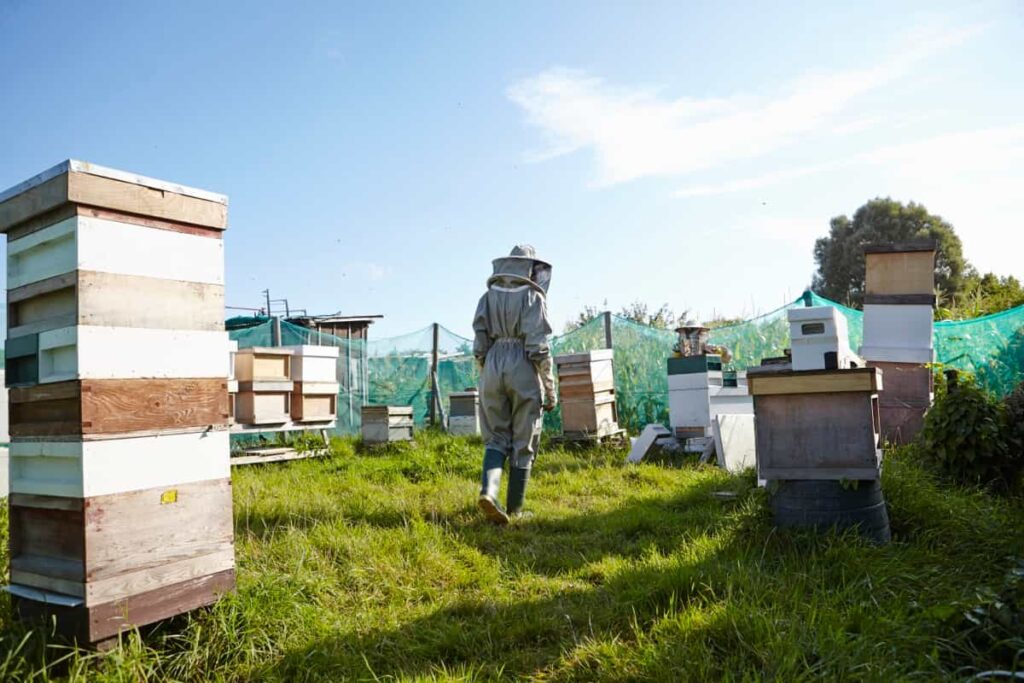
Conclusion
Season-wise management is essential for successful beekeeping. Beekeepers must adapt their practices from spring to winter to ensure colony health, prevent swarming, and maximize honey production. Through careful attention to each season’s unique challenges, beekeepers can nurture thriving honey bee colonies and reap the rewards of their labor.
- Broccoli Varieties: Choosing the Right Cultivars for Your Farm
- How to Raise Pigs in Your Own Backyard: A Comprehensive Guide
- Budget Friendly Sheep Shed Ideas: Cheap and Low-Cost Tips
- How Much Do Cattle Farmers Make: Revenue Streams in Cattle Farming
- Management Pests and Diseases in Your Cotton Field
- Sheep Farming Business Plan for Beginners
- Aquaponic Farming at Home: A Step-By-Step Guide
- Profitable Village Farming Business Ideas in 2024
- High-Yield Aquaculture: Fast-Growing Fish for Farming
- Effective Fish Pond Construction Techniques for Beginners
- Irrigation and Water Management in Pineapple Farming
- Blossom to Harvest: Mastering Flowering and Pollination in Papaya Farming
- Pig Fattening Essentials: From Selection to Sale for Beginners
- Raising Wagyu Cattle: A Complete Guide for Premium Beef Production
- Soil Types and Their Water Holding Capacity
- Optimizing Irrigation Schedules for Coconut Groves for Enhanced Yield
- Espresso Your Garden: Coffee Grounds for Healthier Acid-Loving Plants
- The Best Soil Mix for Snake Plants: How to Mix Your Own Snake Plant Soil
- Green Thumb Success: Expert Tips for Cultivating Greenhouse Beans All Year Round
- Bloom All Year Round: The Ultimate Guide to Indoor Hyacinth Care
- Eco-Friendly Gardening: How to Make Liquid Fertilizer from Kitchen Waste
- Ultimate Guide to Grow Anise in Pots: Explore Seed Propagation to Harvesting
- Guide to Raising Chester White Pigs: Discover Breed Facts to Growth Management
- Mastering the Elegance: The Ultimate Guide to Weeping Cherry Tree Care, Planting, and Maintenance
- Ultimate Guide to Planting Garlic in Grow Bags: Growing Strategies for Beginners
- How to Fix Spider Plant Leaf-Related Problems: Natural and Organic Remedies
- 10 Reasons Why Your Tulsi Plant is Shedding Leaves: Home Remedies and Solutions
- Optimizing Growth and Yield: The Advantages of Palm Bunch Ash Fertilizer
- Utilizing Neem Oil Extract as a Natural Pesticide for Hydrangea
- From Soil to Harvest: Various Ways in Which Farmers Can Use AI Tools
- Steps to Encourage and Induce Citrus Flowers: A Comprehensive Guide
- How to Fix Snake Plant Leaf-Related Issues: Natural and Organic Remedies
- Transform Your Garden into a Fragrant Oasis with Raat Ki Rani (Night Blooming Jasmine)
- Discover the Ideal Chicken Breeds for Philippine Farms
- How to Create a Poultry Egg Farm Business Plan for Profits
- Grow Lemon Cucumbers Like a Pro: Insider Techniques for Bountiful Yields
